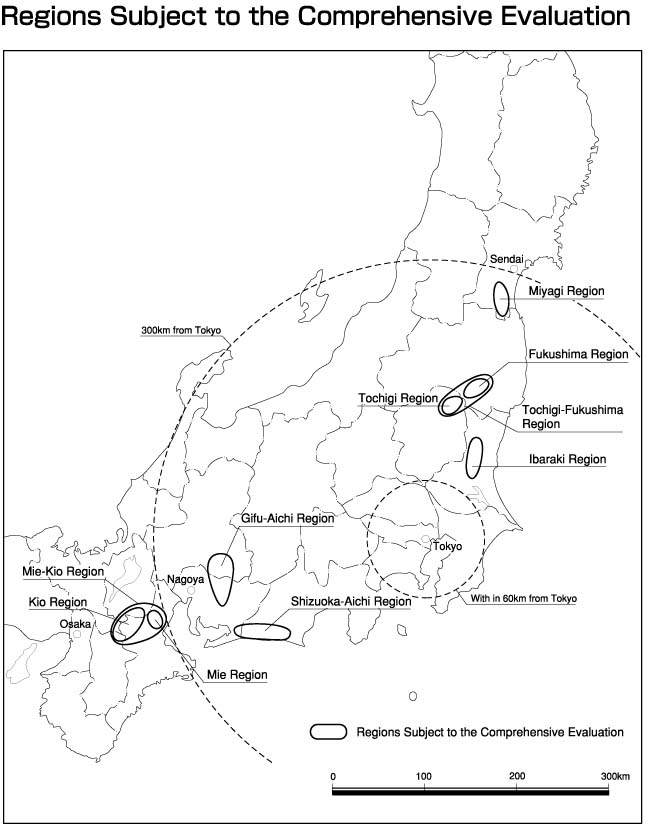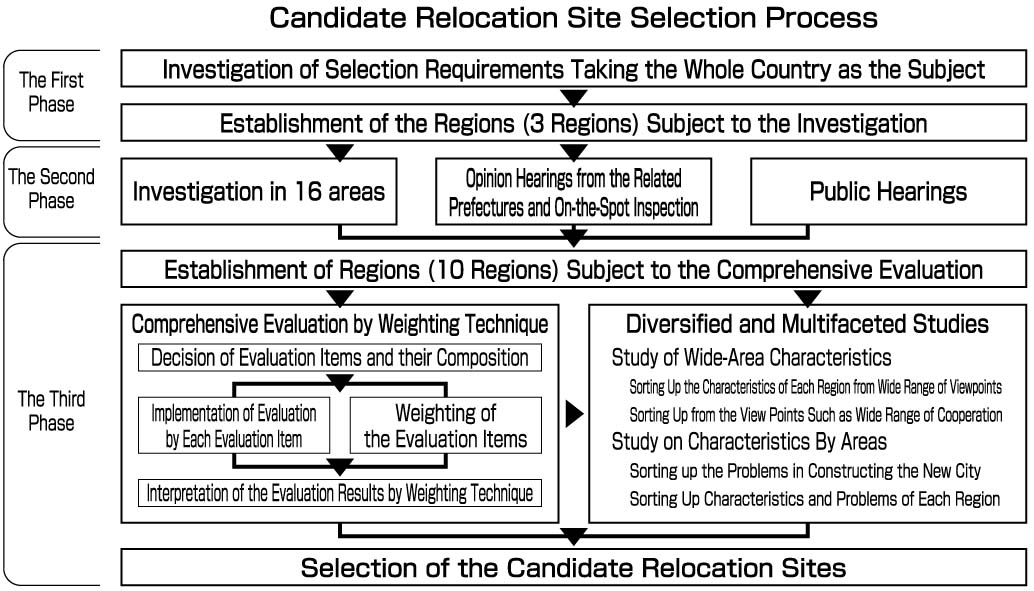Candidate Relocation Sites of the Diet and Other Organizations Decided
|
| - |
-The Council for Relocation of the Diet and Other Organizations
(chaired by Professor Emeritus Wataru Mori of the University of
Tokyo), an advisory body for the Prime Minister, submitted the following
report concerning the relocation sites for the core legislative,
administrative and judicial functions: |
|
| Report
by the Council for Relocation of the Diet and Other
Organizations (Summary) |
| Preface |
| - |
-Following a resolution of the Diet in 1990,
the Council was established based on the "ACT
for Relocation of the Diet and Other Organizations"
enacted in 1992 and partially revised in 1996.
Responding to an inquiry by the Prime Minister
on December 19, 1992, the Council has investigated
and deliberated candidate relocation sites of
the capital functions in 31 meetings over the
last three years. |
|
|
| Chapter 1--Historical
Significance of the Capital Function Relocation |
|
-Though Japan is now facing a significant historical
turning point, the capital function relocation
is a great historical project that must be considered
from a long-term perspective over the coming century. |
|
|
| Chapter 2--Selection
of the Relocation Sites |
|
-The Council conducted a comprehensive evaluation
applying weighting technique for objectivity and
impartiality. It subsequently selected the candidate
relocation sites through a more diversified and
multifaceted study based on the evaluation results. |
|
|
-"Tochigi-Fukushima Region"
in Tohoku Region or "Gifu-Aichi Region"
in Tokai Region were selected as the candidate
sites. |
|
-"Ibaraki Region" is expected
to play a role in supporting and supplementing
--"Tochigi-Fukushima Region" in
collaboration with the latter because it
has superior features such as safety against
natural disasters.
-"Mie-Kio Region" has very unique
features, so it can qualify as a candidate
relocation site if furnished with a new
high-speed traffic network in the future.
|
|
-Assuring the full-scale operation of
the capital functions at the relocation
site in the initial phase is not feasible
and, therefore, cooperation with the other
regions surveyed and broad cooperation with
Tokyo and other large cities such as Sendai,
Nagoya, Osaka and Kyoto are required. |
|
|
|
| Chapter 3--Image
of the New City, the Capital Function Relocation
Site |
|
| -Construction of a new information network
system |
| -Environmental considerations |
| -Provision of functions as an international
political city |
| -Formation of elegant landscape with
a distinctive style |
|
|
|
| Chapter 4--Significance
and Effects of the Capital Function Relocation |
|
| -Reform of the whole national policy- |
| -Correction of monopolar concentration
of activities in Tokyo |
| -Strengthening of disaster response capability |
|
|
|
| Chapter 5--Issues
Requiring Consideration at the Candidate Relocation
Sites |
|
|
-The Council seriously requested
that all conceivable measures be taken quickly
to prevent --speculative real estate transactions.- |
|
-The related local public
bodies are requested to undertake their
responsibilities according to their means. |
|
|
|
| Conclusion |
|
|
-This report is expected
to motivate national understanding and discussions
about the capital function relocation among
the nation to formulate a wide ranging agreement. |
|
-It is earnestly desired
that the Relocation be studied from a wide
point of view to reach an appropriate conclusion
that can bear the criticism domestically
and overseas. |
|
|
|
|
|
|
| Selection
with Focus on Objectivity and Impartiality |
|
(1) Rough Procedure for Selecting Candidate
Site |
| - |
| yFirst Phasez |
-The "Hokuto Region," "Tokai Region"
and "Mie-Kio Region" were established as the regions
which should be subjected to a wide range of general investigation
and study and followed by detailed investigation. |
|
|
| ySecond Phasez |
-Detailed investigations were conducted by a number of experts.
In addition, hearings to determine the opinions of the related
prefectures, on-the-spot inspections by the Council members,
and public hearing at nine places throughout Japan were held
in parallel. |
|
|
| yThird Phasez |
-Candidate relocation sites were selected after comprehensively
evaluating each region numerically based on the investigation
results in the second phase. Candidate sites were then studied
from diverse and multifaceted viewpoints. |
|
|
|
|
(2) Comprehensive Evaluation (Numerical Evaluation) |
|
Focused on Impartiality and Separating Evaluation
of Regions by Specialized Areas
and Judgment of the Significance of the Areas |
|
-In the comprehensive evaluation, the 10 regions
shown on the map, which were established as regions in which a new
city can be constructed, were investigated. |
|
-The relative merits of each region with regard to
18 evaluation items, such as natural disaster potential and traffic
access, were numerically evaluated by more than 70 experts. Evaluation
item weighting (designation of the importance of each evaluation
item) was separately assigned in person by the Council members.
Numerical evaluation results were then calculated for each of the
10 regions subject to the comprehensive evaluation. |
|
-The results were not so different but "Tochigi-Fukushima"
Region acquired the highest evaluation (352 points) followed by
"Aichi-Gifu Region" (340 points). These two regions have
different features. The "Ibaraki Region" obtained the
next highest evaluation (333 points) following the first two regions. |
|
|
|
 |
|
|
|
(3) Diversified and Multifaceted Study |
|
Further Study Referring to the Numerical Evaluation
as Valuable Reference |
|
|
|
-Diversified and multifaceted studies have been made
on broad aspects of the region, coordination between the new city
and the other regions, countermeasures against natural disasters
such as earthquake, and problems for constructing the new city.-
-The candidate relocation sites were finally selected after studying
about the Tochigi-Fukushima Region and the Gifu-Aichi Region that
had obtained the highest evaluation in the comprehensive evaluation
and studying other appropriate candidate relocation site at the
same time.
|
|
 |
|
|
Future Activities |
|
-In the future, the relocation will be studied through
comparison with Tokyo considering various conditions such as the
national agreement formation status and various social and economic
conditions. The Diet will then separately enact a law concerning
the relocation site based on this report.
-Appealing to the Diet, the highest national authority, which has
led the studies on the capital function relocation, the report states,
"It is earnestly desired that this report be sincerely accepted
and Japan's future be sincerely studied from a broad viewpoint to
rapidly reach an appropriate conclusion that can bear criticism
domestically and overseas.
|
|
|
| Further
Discussions by the Whole Nation |
|
-The capital functions cannot be relocated in a short
time. The new city must be nurtured over a long period of time by
the citizens including younger generations.
-It is expected that understanding of the capital function relocation
will be deepened, discussions promoted, and broad consensus formulated
throughout the nation. Nurturing the new city will then become the
desire of the whole nation. |
TOPIC |
Think Together about the Image of the New City! |
|
Towards Construction of a System
for Experiencing a Capital Function City |
|
-The National Land Agency is
studying the image of the new city (capital function city), the
relocation site for the Diet and other organizations, and the
lifestyle assumed in it.
-As part of the study, the "Capital Function City Experiencing
System," which people can use to virtually experience the
urban environment and urban activities in the new city, is under
construction.
| The Capital Function City Experiencing System
Homepage was recently established to take the following actions: |
|
Introduce the experiencing system development status and
examples of new measures concerning the city construction |
|
|
|
Address registration for the mail magazine (providing information
about the experiencing system development status and others
by E-mail). |
|
|
| In addition, the following actions are being
taken as part of the citizen participation studies: |
|
-Implementing an inquiry through the Internet (the results
are now being reviewed). |
|
|
|
-Openly inviting ideas about urban construction in the capital
function city*. |
|
|
|
-Openly inviting life styles assumed in the capital function
city*. |
|
*Invitation requirements are shown on the
Experiencing System HP (Invitation Closing Date: February
10 (Thurs.) |
-Opinions submitted will be utilized as references for developing
the experiencing system. The development status of the experiencing
system will be introduced on the Experiencing System Homepage and
the Capital Function City Experiencing CD-ROMs that will be produced
at the end of March 2000 and distributed to local public bodies,
schools and others.
-For details, please refer to the Experiencing System HP (The "Virtual
Capital Function City" is accessible from the National Land
Agency Capital Function Relocation Homepage (Refer to the end of
this issue)). |
|
Accessing Various Information |
| - |
-Various information concerning the capital functions relocation
has been being provided on the National Land Agency Homepage on
the Internet.
-Also if you are interested in items described in this leaflet and
others, please let us know. We will pleasingly send related documents
to you. We are awaiting your contact.
|
|
|
| We are Waiting for Your
Contact |
| - |
Address: Capital Functions Relocation Planning Division, Metropolitan
Areas Development Bureau, National Land Agency2-2 Kasumigaseki 1-Chome,
Chiyoda-ku, Tokyo 100-9972 JAPAN
Homepage:http://www.mlit.go.jp/kokudokeikaku/iten/index.html
E-mail:hqt-itenka(a)gxb.mlit.go.jp (Please replace (a) with @)
|